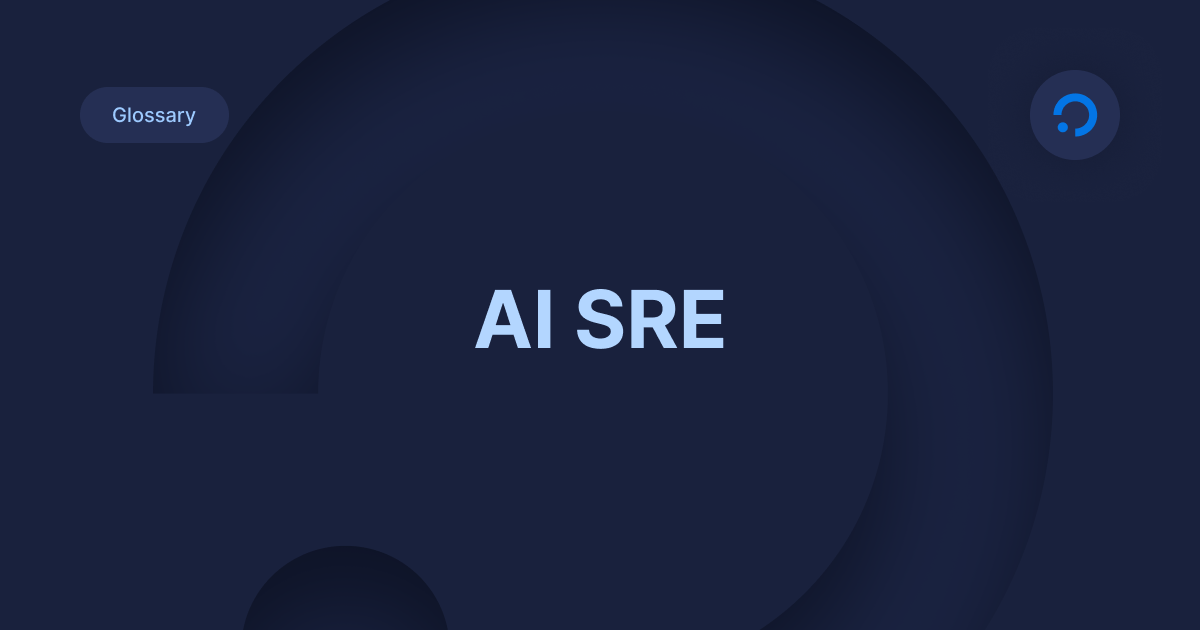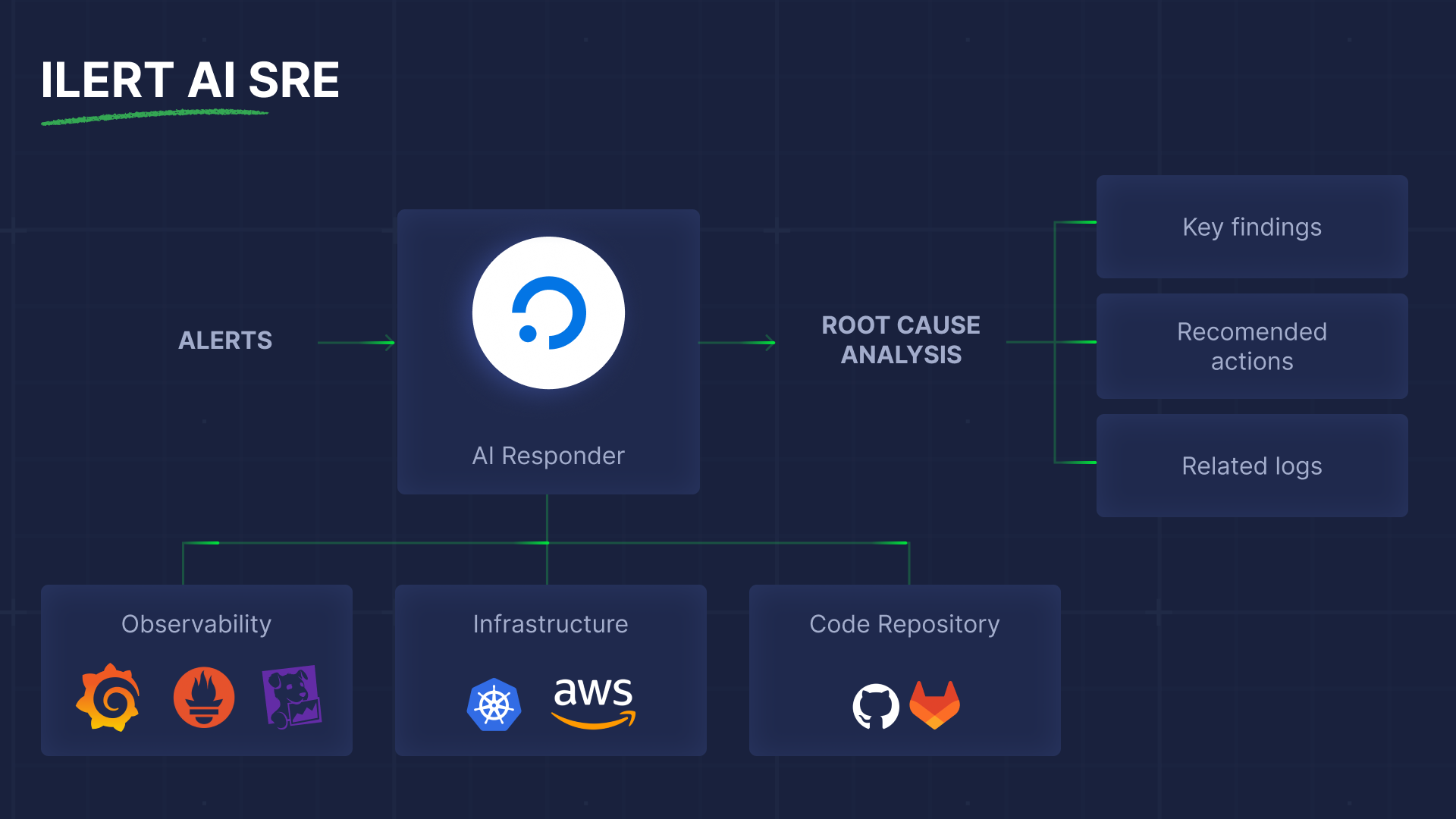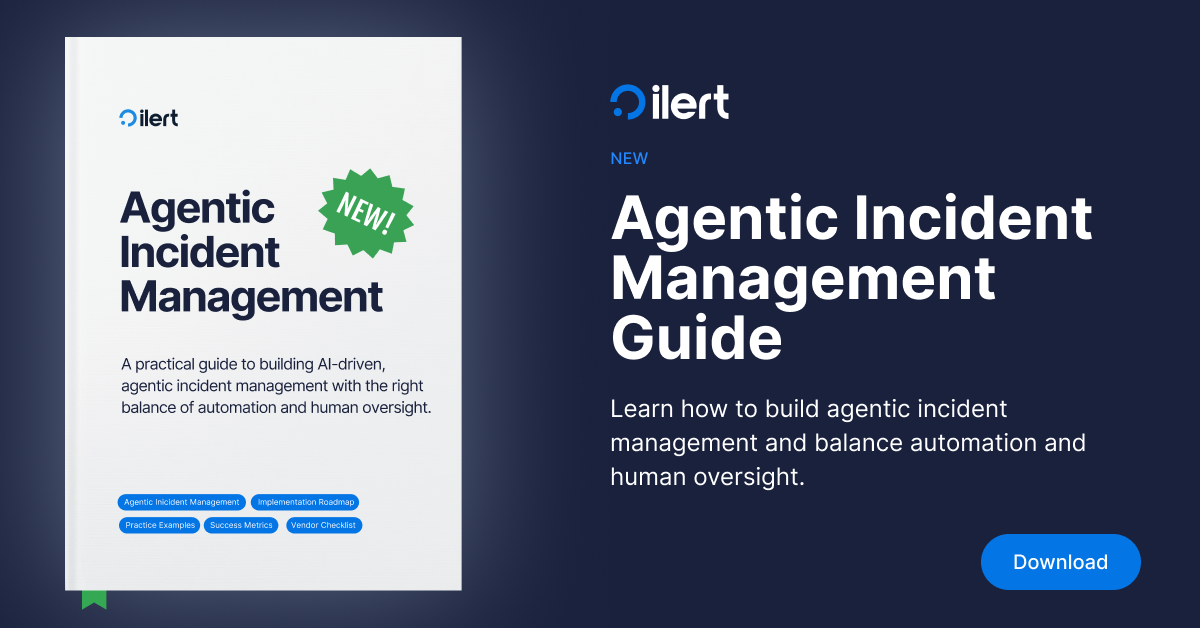What is AI SRE?

AI SRE applies artificial intelligence to Site Reliability Engineering to reduce toil, speed up incident response, and boost service stability. AI SREs are autonomous AI agents that monitor, investigate, diagnose, and even resolve incidents in production environments.
Unlike general-purpose copilots or chatbots, AI SREs are purpose-built for reliability and incident response. They are evolving from reactive responders into proactive, self-healing, and continuously learning systems that enhance operational efficiency.
In this glossary article, you’ll learn how AI SRE is evolving, how we build agentic incident response in ilert, and how to introduce autonomous agents safely within your company.
What is AI SRE?
AI SRE augments Site Reliability Engineering with AI models and agents that analyze telemetry, recommend or execute runbooks, and keep humans in control through policies and approvals. It is adjacent to, but not the same as, AIOps, which focuses on automating IT operations such as event correlation and anomaly detection. AI SRE brings those capabilities into the SRE toolkit and ties them to reliability goals, guardrails, and on-call workflows, with the aim of achieving minimal human intervention in routine operational tasks.
The incident response problems AI SRE solves
Modern systems generate a flood of signals, including metrics, logs, traces, deployments, feature flags, and infrastructure changes. During incidents, responders spend precious minutes filtering alert noise, collecting context, searching for root causes, and hunting for the right runbook. The consequences are predictable: slow MTTA and MTTR and degradation of customers’ trust.
Three structural issues make it logical to introduce an intelligent layer to the processes of managing incidents:
- High operational load. Manual triage and repetitive fixes consume time that should be allocated to engineering work that prevents future incidents. Configuration changes can create additional operational noise and complicate investigations.
- Context is scattered. The knowledge to fix incidents lives across dashboards, wikis, chat logs, and postmortems. Humans can assemble this, but not instantly, and not at 03:00.
- Humans are humans. Even automated escalations are still slow. Tier-1 teams can become overwhelmed with logging tickets and handling basic troubleshooting, which delays involving the right experts.
AI SRE can automate the investigation process, analyze similar alerts, and help find root causes with greater speed and accuracy by conducting parallel investigations and reducing the time needed to investigate issues.
Benefits of AI SRE
Integrating Artificial Intelligence into Site Reliability Engineering unlocks a new level of efficiency and resilience for engineering teams managing production systems. AI SRE transforms incident response by automating root cause analysis, enabling teams to resolve incidents faster and with greater accuracy. By deploying AI agents, organizations can minimize human intervention in routine troubleshooting, allowing engineers to focus on higher-value engineering work that drives long-term reliability.
AI SRE directly improves system health by reducing downtime and accelerating time to resolution. Autonomous agents can detect, diagnose, and even fix issues before they escalate, paving the way for self-healing systems that maintain site reliability with minimal manual effort. This shift not only reduces the operational load on SRE teams but also empowers engineers to spend more time on proactive improvements rather than reactive firefighting.
By leveraging artificial intelligence, engineering teams can ensure their systems remain robust, reliable, and ready to meet the demands of modern production environments.
How AI SRE works

AI SRE is an innovation. Every company is approaching its development differently, prioritizing different aspects. Here is how we build it in ilert.
AI SRE operates as a layer of intelligence embedded into your reliability stack, combining observability, automation, and human expertise into a single feedback loop. Its role isn’t to take over incident management, but to augment it with continuous, context-aware reasoning and to automate repetitive or repeatable tasks.
Real-time analysis and context assembly
At the core of ilert’s AI SRE lies the intelligent agent that integrates with your existing observability systems – metrics, logs, traces, and CI/CD platforms. When an alert fires, the agent instantly:
- Correlates signals across sources to filter out noise;
- Analyzes logs, metrics, and recent changes autonomously;
- Surfaces patterns linked to similar past incidents or ongoing anomalies;
Agent delivers a single, evidence-based incident insight that explains what changed, where, and why it might have happened.
Intelligent recommendations
AI SRE doesn’t act blindly – it assists. ilert’s agent uses probabilistic reasoning and large language models to suggest next best actions, such as rollback or remediation options based on past fixes, and more. The agent can also suggest code changes or fixes as part of remediation options. Every suggestion is transparent and explainable, allowing engineers to see exactly which data led to a recommendation. This keeps humans in the loop while enabling faster, data-driven decisions.
On the next stage, Agents can perform all those actions autonomously if you give them permission. It is important to test AI SRE actions in non-critical environments before deploying them in production to ensure reliability and safety.
Conversational understanding
AI SRE communicates in natural language. Engineers can talk to agents like they would with their colleagues: “What caused this latency spike after the last deploy?” or “Have we seen this alert before?” The ilert AI SRE responds with direct, evidence-backed explanations, citing log entries, deployment diffs, or related incidents – turning scattered operational knowledge into concise answers.
Architecture and security by design
ilert AI SRE is designed for observability without overreach.
- Read-only at the beginning: Ensuring it never changes production state unexpectedly.
- Autonomous with your permissions: When you are ready, you can give Agents more freedom to act on your behalf.
- Fully auditable: Every insight, question, or recommendation is logged for review.
- Compliant and secure: It respects organizational data boundaries and privacy standards.
- Operates within a defined environment, respecting its rules and configurations.
This architecture strikes a balance between intelligence and control. If you want to learn more about how to switch from read-only to autonomous mode, jump to the chapter “How to progressively adopt AI SRE.”
Can human SRE be replaced with AI?
A short answer is no.
SRE is a socio-technical discipline grounded in engineering judgment, risk trade-offs, and cross-team coordination. AI should automate a significant portion of repetitive operational work and serve as a copilot, while humans remain responsible for risk assessment, prioritization, and customer impact. The pragmatic goal is to move more work from toil to engineering – aligning with the SRE principle of keeping operational load no higher than 50% of the time.
What’s the difference between AI SRE and AIOps?
AIOps focuses on automating IT operations such as event correlation and anomaly detection. AI SRE extends these ideas into incident management and reliability, adding context-aware reasoning, automation, and integration with on-call workflows.
How to progressively adopt AI SRE
No organization wakes up ready to give AI full control of production systems – nor should it. Trust is earned, not assumed. Agentic incident management is about gradually introducing AI assistance into operations while maintaining human oversight and safety at every stage.
To help you gradually introduce AI SRE, we divided the process into three autonomy levels. It is important to test AI SRE recommendations and actions in controlled environments before full deployment, ensuring trustworthiness and minimizing risk.
- Level 1: AI serves as a co-pilot, offering recommendations while humans maintain full control.
- Level 2: AI agents begin to take action within defined guardrails and under human supervision and approval.
- Level 3: Agents can manage routine incidents end-to-end, escalating to humans only when needed.
Each stage comes with its own technical requirements and risk considerations. If you want to learn more and introduce AI SRE in three stages in your company, we highly recommend the “Agentic Incident Management Guide.”

Conclusions
AI SRE marks a turning point in how organizations approach reliability – not by replacing human judgment, but by amplifying it. The true value of AI in SRE isn’t autonomy for its own sake; it’s liberation from the fatigue of endless notifications, manual triage, and sleep-depriving escalations. By embedding reasoning, context, and automation into the reliability stack, AI SRE restores focus to engineering work that prevents incidents, rather than just responding to them.
The future of reliability engineering isn’t one where humans are replaced; it’s one where they reclaim their REM sleep. After all, nobody was hired to be on call full-time. The most effective AI SRE agents will be those designed with the engineers they serve: systems whose policies, permissions, and escalation rules are co-created with the people who know the consequences of every alert.
When humans define the boundaries, and AI operates within them, reliability becomes a collaboration: one where the alerting system rings less, sleep comes easier, and teams can finally engineer with confidence instead of exhaustion.
Want to start your journey in agentic incident response? Start the free ilert trial today.










